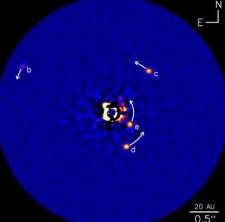
Posted on Friday, December 10 2010 @ 5:00 CET by Thomas De Maesschalck
Astronomers have discovered a fourth planet around the young star HR 8799. Most exoplanets are discovered via indirect methods, but these four stars were all found in a direct image of the HR 8799 system. It's the first multiplanet system directly imaged so far, and the discovery baffles scientists as current scientific theories can't explain the formation and current locations of the planets in the HR 8799 solar system.
According to Marois's team, the problem with such widespread gas giants is that they all couldn't have formed the same way. Too far from the star and there's not enough gas for core accretion to work, but too close and it's too hot for debris to become gravitationally unstable.
"The system is either just too young and the planets are just too far away and don't have time to form before the gas in the disk is depleted, or they are too close and the disk is too warm to form planets," Marois said.
Gas giant planets have been found in orbits close to their parent stars, sometimes even closer than Mercury is to the sun. In these cases, many experts believe the so-called hot Jupiters may have formed farther away from their stars and then migrated closer over time.
More details
at National Geographci.
